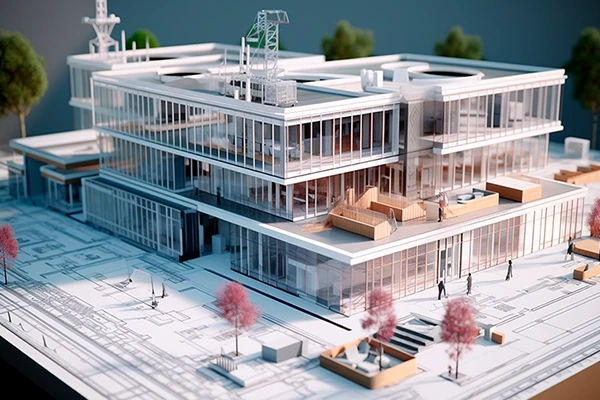
5 Ways BIM Can Mitigate Risk in Construction Projects
Building Information Modelling (BIM) is at the forefront of revolutionizing the world of construction and architecture. However, there are still several challenges that construction companies must deal with. These challenges include site accidents, increased costs, unexpected delays, and inability to meet project requirements; efficient BIM Risk Management can tackle these challenges.
There’s no doubt that BIM has always been helpful when it comes to careful planning of processes and their execution. Nonetheless, there is still a dire need to address the potential challenges and resolve them for smooth project delivery. That can be easily done by utilizing BIM risk management methods during the planning phase. So, let’s explore how BIM aid in risk management in construction.
BIM – A Multifaceted Approach to Construction Management
If we’re to talk about the differences between traditional and modern building methods, it’s safe to say that BIM has started to take the lead. Since BIM allows viewing of physical and functional aspects of places, all stakeholders can easily decide what needs to be done, when, and how it should be done. This not only gives everyone the freedom to create, work on, and manage construction processes but also offers cost-effective solutions for top-notch results.
Oftentimes, BIM is only thought of as a tool that can generate 3D models. Well, there’s more to it. For example, when BIM is incorporated into projects, the stakeholders can work within their set deadlines and budgets. In addition, they won’t have to work with multiple resources all the time but are assigned dedicated Points of Contact to avoid misunderstandings. There are multiple other benefits of BIM implementation, and we are sure you will get familiarized with them sometimes. But right now, it is time for us to formally begin talking about the main topic of today’s blog.
BIM Goes Beyond 3D Model Generation

Okay so, know that BIM doesn’t only generate detailed 3D models but can also mitigate risk; allowing you to keep moving toward project completion. That’s one of the reasons why it has become a preferred choice within the construction and architecture industries. And rightly so; because when you integrate BIM into your projects, you can make informed decisions without having to face costly reworks or delays.
5 Ways BIM Can Mitigate Risk in Construction Projects
In this part of the blog, we will share the 5 ways in which BIM can mitigate risk in your projects. We’re sure that once you are done, you will be able to make wise choices for your ongoing and future projects.
1. Collaborative Working Environment
In conventional building methods, project teams were not able to collaborate and communicate with each other. As a result, they not only faced poor planning but also had to rework many things to get what they hoped for. With the advancement in technology, BIM tools came into play to minimize errors and inaccuracies. Here is how BIM fosters a collaborative working environment – allowing all stakeholders to be on one page.
By working through a centralized platform, everyone can upload, share, and access project data in real time. BIM implementation leads to the effective elimination of errors while also ensuring successful project delivery.
2. Early Clash Detection

The impact of BIM on protect cost savings vis-a-vis clash detection is huge. It’s important to mention that effective clash detection is crucial for construction projects. By implementing BIM into the projects, the stakeholders can’t only detect potential clashes but can also work towards their elimination. Now, there are multiple types of clashes that can arise during a construction project. These clashes are called hard clash, soft clash, and workflow clash. Solutions are offered depending on the complexities of these clashes to keep the show running. Thus, BIM cost-benefit analysis are too high to ignore.
Want to save on construction costs through efficient clash detection?
3. Accurate Cost Estimation and Quantity Takeoffs
Studies show that major risks that can arise during a construction project are due to inaccurate cost estimation. In addition to that, incorrect quantity takeoffs can also become a problem for the stakeholders. BIM can enable the stakeholders to fight this risk efficiently. Allow us to share how:
With the help of BIM, a standardized platform is generated which allows access to accurate data. This data is beneficial for measuring error-free cost estimation and quantity takeoffs. When the stakeholders have access to data that is directly generated from the BIM model, resource allocation becomes easier for them.
4. Improved Visualization Leading to Safety Planning

Traditional building methods were not supported by BIM which could result in creating unsafe working / built environments. However, with the implementation of BIM, the stakeholders are enabled to fully visualize the construction sequences. By doing so, they can also participate in risk mitigation at various phases. This practice overcomes safety hazards, ensures everyone gets to work, and builds safe spaces.
5. Optimized Facility Management
BIM can also mitigate risk in construction projects by offering optimized facility management (FM). We are sure that you know how issues associated with FM can badly impact post-project performance. With the implementation of BIM, that gets sorted in a well-organized manner. Allow us to explain how BIM facilitates FM and its maintenance and this is how BIM improves construction safety.
There are chances that stakeholders would tend to ignore FM-related risks. While that’s not intentional, such risks can result in costly rework. And we are sure that no one would want that to happen. So, what BIM does is that it offers a detailed record of the built structures. This data includes all the relevant information covering assets, operating manuals as well as maintenance scheduling. When facility managers get access to this information, they can execute activities concerning maintenance and optimizing asset performance.
Types of Risks
Following are the types of risks:
1. Risk in the Design Phase
There are several risks that can arise during the design phase of a construction project. For example; design coordination failures, inaccuracy of data, version control issues, data ownership and more. In addition to that, human errors can also impact the project’s progress such as model interpretation challenges and more. However, these risks can be mitigated and the project can be made error-free through the implementation of data validation protocols. Furthermore, the stakeholders can also perform clash detection regularly to resolve clashes. By doing so, they can reduce costly delays and rework.
We must also add that when stakeholders are in contact with each other, they can make informed decisions before it’s too late to make a decision. To achieve ultimate success in construction projects, all parties must coordinate and collaborate regularly to avoid disputes, etc.
Are design phase risks slowing down your project?
2. Risk in the Construction Phase
Similarly, several challenges in the construction phase can hinder a project such as clashes, construction sequencing, etc. Usually, such issues arise because there’s a lack of communication among the stakeholders. To avoid any such risks, it is important that all stakeholders are on one page throughout the lifecycle of a project. By doing so, they can ensure that they meet their client’s demands and build structures that are sustainable – both for on-site workers and the future inhabitants.
3. GIS at integration
GIS integration in any construction project offers a number of benefits. Such as the stakeholders can have access to highly detailed and accurate data. In addition to that, they can enjoy seamless coordination throughout the project’s lifecycle. When GIS is paired with BIM, the stakeholders can make informed decisions in real time. This not only allows a highly collaborative working environment but also ensures smooth project delivery.
Types of Risk Mitigation (budget allocation, project delays, environmental concerns, workforce challenges)
Different stakeholders can implement different risk mitigation strategies to ensure that the project stays on track. In this part of the article, we will share the various types of risk mitigation so that you can make informed decisions.
1. Risks related to Budget Allocation
When it comes to budget allocation, many companies suffer from budget overruns. That happens mainly because there’s a lack of proper planning such as detailed cost estimation. Moreover, the stakeholders do not optimize their project elements for cost, etc. However, with a proper mitigation strategy, the stakeholders can get things done without compromising on the project’s quality. Such as cost tracking systems can be employed to regularly monitor costs. By doing so, the budget can be utilized and adjusted as per the project requirements.
2. Project Delays
Even though certain conditions and situations cannot be predicted, there are a number of things that can be done in order to keep the project on track. For example; the stakeholders must work by developing a project timeline. It should be as realistic as it can be while also keeping a buffer for potential hindrances. In addition to that, everyone must be in direct contact with other disciplines to avoid miscommunication and delays.
3. Environmental Concerns
One of the most effective risk mitigation strategies is to carry out a detailed environmental impact assessment. This will help stakeholders identify potential risks and also work towards their effective resolution. In addition to that, all the disciplines can explore sustainable practices to ensure that their built structures will comply with the local and international environmental standards and regulations.
4. Workforce Challenges
Construction projects might get halted for some time or canceled permanently due to various reasons if construction risk management is not taken into account properly. One of those reasons can be the challenges related to the workforce. But that’s not something that cannot be resolved. For example; the concerned teams can develop a workforce plan to address several aspects such as the recruitment and training processes. Moreover, skilled labor can also be retained for future construction projects as well. Workforce challenges can also be overcome by implementing flexible working hours. In addition, the stakeholders must also ensure the sites are extremely safe for the workers in every sense of the word.
Although BIM doesn’t follow a one-fits-all approach for projects, BIM risk management solutions are extremely beneficial for project management and risk mitigation. This results in ensuring the success of the construction projects. By developing tailored solutions – regardless of the project’s scale, BIM continues to enable stakeholders in every sense of the word. When it is proactively implemented in any project, teams can address potential risks and then resolve them accordingly.
At DDC Solutions, our teams of experts incorporate BIM right when it’s needed so that you can enjoy its maximum potential. So, contact us today to check out how our bespoke BIM solutions can help you in building risk management solutions and make your project cost efficient!


7 Responses